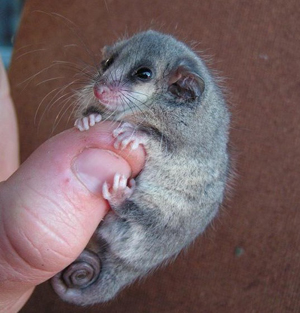Known From Fossils First
While writing your dissertation, you come across many fascinating tidbits written as passing remarks. They are so interesting that you happily spend time chasing down the original references and learning more, only later to find them frustratingly difficult to work into your dissertation. Such is the case with this story, the tale of living animal species previously known only from fossils.
The Mountain Pygmy-possum, Burramys parvus, was first described by Robert Bloom in 1896, based on a handful of jaws he collected from Pleistocene cave deposits (~15,000 years old) in New South Wales, Australia. In 1896, scientists only recognized three families of marsupials: Phalangeridae (Australian/Papuan arboreal possums and their allies), Macropodidae (kangaroos and their allies – basically anything that lived in Australia that wasn’t a phalangerid), and Didelphidae (all North and South American marsupials). Today, living marsupials are divided into seven orders comprised a total of ~22 families. Clearly, a lot of research on marsupial diversity and relationships has been done in the last 115 years.

At the time, Broom noted that the teeth and jaw anatomy of Burramys was distinct from all other marsupials (fossil or living) known at the time. Even just using partial upper and lower jaws, he could tell it wasn’t a great fit with either the Phalangeridae or the Macropodidae. Broom tentatively called it a phalanger, but based on its odd combination of anatomical features, he also proposed it could be a missing link binding the two families together.
Over the next 50 years, a few more Burramys fossils were discovered, but only fragmentary skull and jaw elements. A big part of the problem was that the rock they were preserved in was very hard, and the bone was very soft. Also, the premolar (the large blade-like tooth in the image above) sat at an angle in the jaw such that, as Broom lamented, it was “almost impossible to split the stone without breaking either the bone or the teeth”.
It wasn’t until the 1950s that a new fossil preparation technique helped free the Burramys fossils from the rock and allow their true affinities to be known. Though the limestone was tough to chip or break away with tools, it could easily be dissolved away using acetic acid, better known as vinegar. W.D.L. Ride went back to the original fossils collected by Broom, coated them with a protective layer of methyl methacrylate, poured some vinegar on them, and dissolved the rock away. He could do this because Broom had deposited the fossils in a natural history museum collection (hey, add this to your list of examples of how museum collections enable scientific research decades after specimens are originally collected).

Image from amazon.com.
In 1956, scientists were still debating whether Burramys was some sort of weird primitive kangaroo or some sort of weird phalanger. Ride (1956) described the newly-prepared Burramys specimens in great detail and showed that while it did have some macropod-like characteristics, it was definitely much closer to the possums. Burramys shared many odd features in common with the pygmy possums, Cercartetus, a living genus then known only from Tasmania, but with fossils known from the same mainland fossil localities. Now that scientists knew which features to look for, more Burramys fossils were recognized over the next ten years, and everyone was pretty content that the great Burramys mystery had finally been solved.
In August 1966, a live Burramys parvus was discovered hanging out in a ski lodge on Mount Hotham in Victoria.
This was a spectacular find, to say the least. Ride (1970) described the event best: “The dream dreamed by every paleontologist had come true. The dry bones of the fossil had come together and were covered with sinews, flesh, and skin.”

Image (c) Fredy Mercay, accessed from Museum Victoria
For a while, it seemed like that ski-lodge Burramys could even have been the last Burramys; it took four more years before another living animal was discovered. Since then, hundreds more have been trapped, but they’re pretty rare; possibly only 2000 or so Burramys exist in the wild and they are listed as Critically Endangered. With the whole anatomy available, subsequent studies (including DNA studies) confirmed a close relationship with Cercartetus; eventually the two genera were deemed unique enough to qualify for their own family, the Burramyidae.
Not wanting to be outdone by its sister-genus Burramys, in the 1970s, two more species of Cercartetus were discovered on the mainland. Where they were previously just known from fossils.

Image (c) Jamie Harris and borrowed from Warra
How does this keep happening? Why are burramyids easier to find in the fossil record than in the living record? Part of this is location, location, location: Burramys is the only Australian marsupial known exclusively from alpine regions. Before its ski-lodge discovery, nobody knew to look for marsupials so high in the mountains. They also have a very specific habitat, so their distribution is restricted to just three geographically-distant populations. Another reason is that both Burramys and Cercartetus are small and nocturnal. Tiny animals (C. nanus is only ~10 grams) running around in the dead of night are hard to observe.
Another factor likely contributing to the delayed discovery of living burramyids is that they hibernate for insanely long times. What I mean by “insanely long times” is that burramyids have the longest reported hibernation of any mammal.Lots of marsupials experience daily torpor, but only seven species hibernate, including the five living burramyids (Geiser 1994). So hibernation in marsupials is weird just on its own.
To get an idea of how weird burramyid hibernation is, I’ll let the original research (Geiser 2007) on Cercartetus nanus speak for itself: “Pygmy-possums exhibited a prolonged hibernation season lasting on average for 310 days. The longest hibernation season in one individual lasted for 367 days.” So if Cercartetus wanted to check out for all of 2013, it could. Burramys is also a champion hibernator, but only checks out for 5-6 months.
Now, I have no idea what the evolutionary or ecological advantage is to waking up at the exact time of the year you started hibernating last year. But I can tell you that if you’re going to look for living burramyids, your field season is shortened by 6-10 months (maybe a year) right off the bat, just from hibernation. I think there’s a good case to be made here that the ecology of the living burramyids helps predict why they might easier to find in the fossil record, where your field season is essentially 15,000 years long (and counting).
References:
Broom, R. 1896. On a small fossil marsupial with large grooved premolars. Proceedings of the Linnean Society of New South Wales 10: 563-567.
Geiser F. 1994. Hibernation and daily torpor in marsupials: A review. Australian Journal of Zoology 42: 1-16.
Geiser F. 2007. Yearlong hibernation in a marsupial mammal. Naturwissenschaften 94: 941-944.
Ride, WDL. 1956. The affinities of Burramys parvus Broom, a fossil phalangeroid marsupial. Proceedings of the Zoological Society of London 127: 413-429.
Ride, WDL. 1970. A Guide to the Native Mammals of Australia. Oxford University Press Australia and New Zealand. Melbourne: 249pp.
